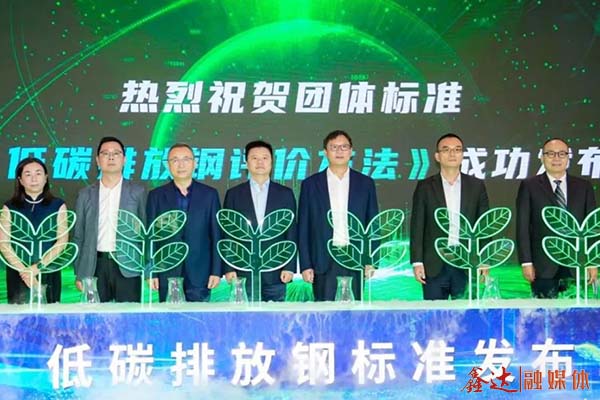On October 18, 2024, the "Low carbon emission Steel Evaluation Method" CISA group standard organized by the China Iron and Steel Association (CISA) was officially released at the 2024 Green Development Digital Wisdom Supply Chain Conference. The standard is led by China Baowu Iron and Steel Group (Baowu), with the participation of 44 units in the industrial chain and the joint efforts of more than 100 industry experts. Jiang Wei, Deputy Party Secretary, Vice President and Secretary General of China Iron and Steel Association; Fei Peng, Standing Committee Member and Deputy General Manager of Baowu; Chen Leiming, Executive Chairman and Secretary General of China Metal Materials Circulation Association; Lu Jun, Party Secretary and Chairman of EuyeYunshang Co., LTD.; Yu Zhen, Deputy General Manager of COSCO Haifa; Li Feng, Minister of Science and Technology of Citic Pacific Special Steel Group; "Low carbon emission steel evaluation Method" standard convenor, Baowu Central Research Institute Technical Director Liu Yinghao attended the meeting and participated in the release ceremony.

Liu Yinghao said that at present, carbon emissions have become a new variable affecting international trade. More and more downstream users have put forward procurement requirements for low-carbon emission products, and international steel peers are also actively promoting low-carbon emission product brands. However, the global low carbon emission steel standards are fragmented and diversified, and a unified or mutually recognized standard system has not yet been formed. According to statistics, there are dozens of institutions or enterprises around the world studying low-carbon emission steel standards, including third-party advocacy organizations, steel enterprises, financial institutions and downstream users. This inconsistency of standards has brought many troubles to the steel industry and enterprises. In this context, the release of the "Low carbon emission steel Evaluation Method" standard has become an important practice for China's steel industry to respond to international trade policies, achieve sustainable development and low-carbon transformation of steel, and meet the supply demand of social green products. On the basis of following international rules, the China Iron and Steel Association has organized a standard preparation group, adhered to the principle of "common but differentiated responsibilities", and established a low carbon emission steel product evaluation method in line with China's development characteristics and resource and energy endowments.
Since its launch in November 2022, after two years of research, through the joint efforts of many parties, the "low carbon emission steel Evaluation Method" standard was finally approved on September 29, 2024, and officially released and implemented on October 18 of the same year. The introduction of this standard, which embodies the wisdom and effort of 44 enterprises and institutions in the steel industry and more than 100 experts, relies on the large-scale data support of about 350 million tons of crude steel production capacity emissions, and has become one of the most detailed and informative templates of similar standards in the world so far. Throughout the standard development process, the standards preparation Group maintained close communication and cooperation with the international mainstream low-carbon emission steel preparation related institutions, such as the International Energy Agency, Responsible Steel, Germany Low carbon emission Steel, Rocky Mountain Institute, etc. The research results were presented at several important platforms such as the World Trade Organization (WTO) and the 28th Conference of the Parties to the United Nations Framework Convention on Climate Change (COP28). In addition, during the development of the standard, it also actively communicated with representatives of downstream industries such as automobile manufacturing, household appliances and construction, fully listened to the views of end users and incorporated reasonable suggestions into the standard development process to ensure its applicability and forward-looking.
The "Low carbon emission Steel Evaluation Method" standard is based on meeting the goals and requirements of the national dual carbon strategy and the Paris Agreement, following the life cycle assessment (LCA) methodology, recognizing the decarbonization contribution of different carbon reduction processes, encouraging the coordinated development of multiple carbon reduction technologies, and setting fixed accounting boundaries to ensure data comparability. It can realize the greenhouse gas emission accounting and greenhouse gas emission grade (carbon efficiency grade) evaluation of crude steel or hot rolled products. The release and implementation of the "Low carbon emission Steel Evaluation Method" provides a scientific and systematic basis for iron and steel enterprises to release green brands, low carbon emission products, and downstream users to carry out green procurement, which can help steel and the whole upstream and downstream industrial chain and the whole value chain to low-carbon transformation development. As Jiang Wei, vice president and Secretary general of China Iron and Steel Association, said in his speech at the meeting, the official launch and release of the standard is another important milestone in the low-carbon transformation of China's steel, and the standard will become an important carrier linking low carbon steel and green trade in downstream industries.
The "Low carbon emission Steel Evaluation Method" standard is the "China plan" proposed by the wisdom of China's steel industry, which is not only the concrete embodiment of China's steel industry's commitment to emission reduction, but also the firm pursuit of future sustainable development goals, highlighting China's positive role in the green and low-carbon development of the global steel industry. The China Iron and Steel Association is organizing the formulation of supporting working methods to carry out the evaluation work in the industry in an orderly manner.

 Email
Email Email
Email
